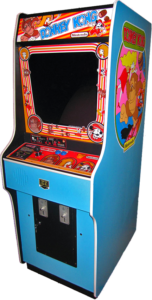 Around 1960, a small boy who liked to explore nature without a map was wandering in the forest near his village. He was frightened when he accidentally discovered the entrance to a cave in the woods. Later, he got up the courage to return alone from his house with a lantern. His decision to explore the cave’s passageways would take on greater meaning in the years to come.
Around 1960, a small boy who liked to explore nature without a map was wandering in the forest near his village. He was frightened when he accidentally discovered the entrance to a cave in the woods. Later, he got up the courage to return alone from his house with a lantern. His decision to explore the cave’s passageways would take on greater meaning in the years to come.
The boy was Shigeru Miyamoto and he grew up to be one of the founding fathers of electronic game design. As a young man, he wanted to be a manga artist and went to college for art and design. After graduation, his father got him an interview at an old Japanese company that specialized in playing cards, but had begun to expand its offerings into electronic toys – Nintendo. Miyamoto brought children’s clothes hangers in the shape of animals that he had designed and convinced the company to hire its first artist.
 A couple of years later, motivated by the huge success of video arcades, Nintendo built their own version of Space Invaders that failed dismally. Stuck with two thousand unsold arcade units, they turned to their artist and asked if he could come up with a better game. At this time, video arcades games, while popular, were little more than shapes shooting and attacking other shapes. But in 1982 that all changed when Nintendo released Miyamoto’s Donkey Kong. Donkey Kong was the first arcade game with a story and characters – a gorilla, the girl he kidnapped but loved, and a hero – a carpenter known in this game as “Mr. Video,” later “Jumpman,” and finally, “Mario” (named for the landlord of Nintendo’s warehouse in Seattle, Washington). Continue reading
A couple of years later, motivated by the huge success of video arcades, Nintendo built their own version of Space Invaders that failed dismally. Stuck with two thousand unsold arcade units, they turned to their artist and asked if he could come up with a better game. At this time, video arcades games, while popular, were little more than shapes shooting and attacking other shapes. But in 1982 that all changed when Nintendo released Miyamoto’s Donkey Kong. Donkey Kong was the first arcade game with a story and characters – a gorilla, the girl he kidnapped but loved, and a hero – a carpenter known in this game as “Mr. Video,” later “Jumpman,” and finally, “Mario” (named for the landlord of Nintendo’s warehouse in Seattle, Washington). Continue reading
